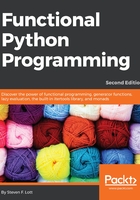
To get the most out of this book
This book presumes some familiarity with Python 3 and general concepts of application development. We won’t look deeply at subtle or complex features of Python; we’ll avoid much consideration of the internals of the language.
We’ll presume some familiarity with functional programming. Since Python is not a functional programming language, we can’t dig deeply into functional concepts. We’ll pick and choose the aspects of functional programming that fit well with Python and leverage just those that seem useful.
Some of the examples use exploratory data analysis (EDA) as a problem domain to show the value of functional programming. Some familiarity with basic probability and statistics will help with this. There are only a few examples that move into more serious data science.
You’ll need to have Python 3.6 installed and running. For more information on Python, visit http://www.python.org/. The examples all make extensive use of type hints, which means that the latest version of mypy must be installed as well.
Check out https://pypi.python.org/pypi/mypy for the latest version of mypy.
Examples in Chapter 9, More Itertools Techniques, use PIL and Beautiful Soup 4. The Pillow fork of the original PIL library works nicely; refer to https://pypi.python.org/pypi/Pillow/2.7.0 and https://pypi.python.org/pypi/beautifulsoup4/4.6.0.
Examples in Chapter 14, The PyMonad Library, use PyMonad; check out https://pypi.python.org/pypi/PyMonad/1.3.
All of these packages should be installed using the following:
$ pip install pillow beautifulsoup4 PyMonad